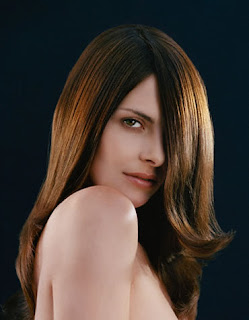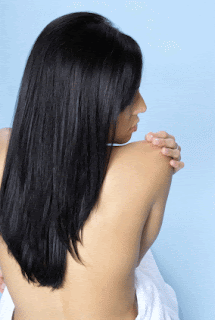Growing long, beautiful and healthy hair is not an extremely difficult process. It does not require a multitude of salon hair products, handfuls of expensive vitamins, nor any sort of sacrifice to the long hair gods. What it does take to grow your hair long and keep it in good condition is common sense, dedication, and a lot of patience. Indeed, growing long hair is actually more a question of what you shouldn't do rather than what you should!
For the sake of comparison with your own hair, at the time of the writing of the first edition of this guide my hair was 33" long, very straight, fine (pertaining to the thickness of each hair), reasonably thick (pertaining to the thickness of my hair as a whole) and had no gray (that's changed... I'm hoping for a streak!). Please feel free to experiment and tweak the below steps to best suit your own hair type and hair growth goals.
1. The first step to growing long, beautiful hair is by far the most important. It is absolutely non negotiable for anyone who wants healthy hair at any length, but it is also by far the hardest step you will have to follow. Because there is absolutely no way to repair damaged hair, you must start out with healthy hair to have healthy hair when it's long, there's no way around it. Bite the bullet and remove every inch of hair that is considerably damaged, reminding yourself that it's the most important step to take towards your long hair goal and that this is the last time you will ever have to do it. If you are going for extreme hair length, from this point on you will have to treat your hair at all times like delicate, antique lace. Once your hair is at your waist the ends can be as many as six years old, and your hair will go through a lot of trauma in those six years no matter how careful you are with it. Because damaged hair will only get worse as time passes, it is especially important your hair be in excellent condition from the very beginning.
Remember, long damaged hair is never as pretty as shorter healthy hair, and because healthy hair needs to be trimmed less often and doesn't break as easily, the result is much faster growth overall. I learned this step the hard way and wasted ten years trying to grow damaged hair I refused to cut... hair that started literally growing like a weed when I finally gave in, did the dirty deed and stopped doing all the horrible nasties that initially resulted in the damage. Duh. Learn from my pain.
If your hair is not very damaged too far up the length of the hair shaft, you may start with a very healthy trim and then continue to trim monthly to maintain your hair length until all the damage is gone; however, keep in mind that if the amount of damage does not continue to decrease using this method, you didn't remove enough of the damaged hair to begin with and another healthy trim is in order. You'll save precious time by removing as much damaged hair as possible from the very beginning and immediately implementing the steps that follow to your now beautifully healthy hair!
2. Always trim your hair often. Damage to your hair will move up from the ends and the only way to stop it in its tracks is to remove it as soon as it happens. Use good tools to trim your hair, using anything else can actually encourage more splitting down the road! It's important the scissors or shears you use be very sharp, made specifically for cutting hair, and used for nothing else. The small investment you make in a good pair of hair styling scissors will pay off many times in the long run. Trim hair a half inch every month or so (the average rate of hair growth) if you are maintaining your length. If you are actively growing your hair, trim it a half inch every three or four months. In between trims it is beneficial to sit in bright light and snip any splits off the ends of individual hairs with your good scissors. Don't forget to explain to the men in your house that these are your hair tools and are absolutely not to be used for anything else, especially prying off bottle caps when they can't find the bottle opener, which is of course in the drawer where it belongs if they'd just look. I digress. If you are persistent with this method, regular trims may be able to be postponed even longer. If your hair begins to show damage, it is important to trim it more often! Damaged hair doesn't grow, it breaks and if you let it go, the damage will only get worse.
3. If you don't have someone you trust implicitly to trim your hair for you, find a salon that caters to long hair, has a long hair specialist, or at least be sure to glare at your stylist as menacingly as you can while you clearly explain your hair-growth goals before letting her come at you with scissors. It also helps to ask the stylist to show you exactly their perception of the amount of hair you want trimmed by showing you what they think is the same distance from the end of their comb. I am convinced stylists are taught a completely different measuring system from the rest of the world, and not once have I ever had a stylist show me an accurate half inch on her first try. Not once. It also helps to remember, it is not in the best interest of most salons or stylists if you rarely make visits to their salon, which is definitely a conflict of interest! If your hair is short and styled, you are always at the hair salon spending money for maintenance. If your stylist tries to convince you that your long, healthy hair should be cut, run screaming from the salon immediately!
In the end, it is up to you to make sure that anyone whose advice you consider, be it a stylist, friend or family member, has only the best interest of YOUR acknowledged hair growth goals in mind. Otherwise smile politely and ignore every word they say. You absolutely are not too old, too thin, too short, too gray, too anything to have long hair.
4. Avoid using any heated appliances whenever possible. No blow drying, no curling irons, no hot rollers, and especially no flat irons or hair crimpers! If you absolutely must blow dry do so minimally, and contrary to popular belief, it is best to let your hair dry naturally for as long as possible and use the blow dryer just to finish it off at the end. If you must use hot rollers, use flocked or ceramic rollers that are safer for your hair, not spiked plastic rollers (and be sure to read about all the great alternative methods in our Ultimate Guide to Curling Long Hair first!) If you insist on using curling irons, flat irons or hair crimpers on a daily basis, really long healthy hair isn't in your future. If you do use any kind of heat on your hair, be sure to use a product that will help protect your hair from it, but keep in mind that every time you apply heat you are likely to cause some damage.
5. Don't use any harsh chemicals on your hair. Definitely no perms and no peroxide! If you must color, use non peroxide color or 100% natural henna (henna comes in a full range of colors, not just red). In addition to being an all-natural way to add color to your hair, henna will "plump up" and add body to fine hair (but it's best not to use it on very dry hair). Check out our Hair Care Recipes Cookbook too, and learn to make your own organic hair color and products.
Low-peroxide hair color is much less damaging to hair than permanent color, but using these products again and again will eventually detrimentally affect the health of your hair, it is unavoidable. If you do choose to go this route, you will have to be even more diligent about taking care of your hair. Be sure to use a good daily shampoo and conditioner forumlated specifically for color treated hair, which will make your color last longer, which equates to less exposure to damaging chemicals in the end. Using a line of shampoo and conditioner that adds a bit of color to your hair will make it last even longer. And be sure to deep condition your hair often, again using a product forumated especially for color treated hair. With making the color in your hair last as long as possible as the primary goal so as to limit how often you have to use hair color, you may also want to consider using a leave-in color protectant. In the end, it's much safer, and less work and expense, to learn to love the hair color you have, or at least to use a hair coloring product that doesn't contain any peroxide at all. Now, having spoken to hundreds of customers addicted to color over the years, I know how difficult it is to convince you kidz not to use it. That being the case, the least I can do is tell you how to use it while keeping damage at a minimum and long, gorgeous hair in your future. In this instance, 16oz. of prevention is definitely worth a ton of cure.
Lastly and by far most importantly, never perm or straighten your hair for any reason. These products actually break down the chemical structure of your hair and rebuild it... no other chemicals meant to be applied to hair are more damaging. If you want long healthy hair, you just can't use these type of chemicals on it. Ever.





You have read this article Tips For Healthy Long Hairs
with the title Tips For Healthy Long Hairs. You can bookmark this page URL https://vintagemuse5.blogspot.com/2011/08/tips-for-healthy-long-hairs.html. Thanks!









No comment for "Tips For Healthy Long Hairs"
Post a Comment